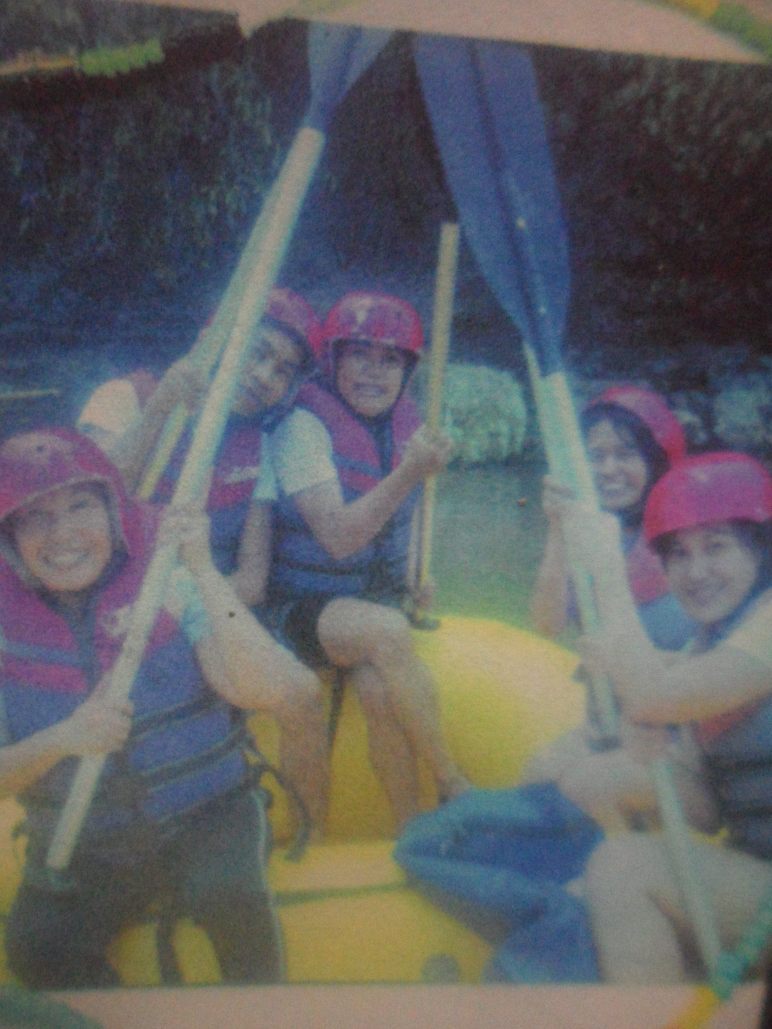by Maria Eleanor E. Valeros, #newmedia specialist
caption: This blogger (center) with fellow writers.
CAGAYAN DE ORO, MISAMIS ORIENTAL, PHILIPPINES — White-water rafting is all about negotiating river rapids and obstacles in an inflatable rubber boat called a “raft” with a team of up to eight people and a river guide.
Rivers are graded from easy to near impossible according to size, the intensity of their rapids, and the difficulties that may affect rescue attempts.
Though the experience was a first, I banked on the assurance given me by the pros that it is not necessary to have precious knowledge on rowing. But among its few preconditions is to make it sure that the participant loves rivers, and or nature.
The Rio de Cagayan sent us on a gentle float with a water level of 3 which goes up to 5 or 6 on rainy days. We glided onboard a yellow raft on the water surface smoothly and negotiated its swells, following the run of the Rio, befriending the nature of the 14 rapids – 9 and 13 being the most challenging for white water action.
Bonding with my paddle with the easy and double forwards, and back paddle gave me my white-knuckle ride of a lifetime. With a heap of mentoring from our river guide who chose to be referred to only as “Babars,” I learned to move in synchrony with the rest of my boatmates so to move our raft.
Babars, I could sense assumed all the responsibility in maneuvering the raft right after we first-timers flawed in our paddling moves. His expertise allowed us to conquer smoothly all first four rapids. Highly qualified, experienced, and enjoys working with people, with a load of patience too (I guess guides do really have this sense of community with people they go with even for the first time) and his capacity of leading us neophytes in a competent and professional manner, he then won my respect. A seasoned river runner, indeed!
After the fourth rapid, we reached this footbridge (connecting amazingly one side of Cagayan de Oro in Misamis Oriental to a barangay of Bukidnon province) where we tried simulating some death leaps at 25 feet. Confident at my lifesaving gadgets, I leapt twice. I plunged into a deep portion of the Rio and moved on to deal with the fifth rapid where we were made to jump out of the raft, taken swiftly by the current like floating logs on a portion I personally called the “Boulder Creek” – monuments that speak eloquently how the force of water can serve as chief of sculptors.
On the 9th rapid, our guide told us it was the most challenging to deal with because most rafts capsize in there. That was what I labeled Disastrous Fall. Babars instructed us to make fast paddles and make sure we won’t hit rocks protruding like tips of icebergs. I began praying for too much water so to make less the exposure of rocks. But then it saved us from much larger waves and boat-eating holesin places that must be avoided. Since Babars has his way with the river already, he was adept at maneuvering the raft for us. My heart just thumped at the sight of the swell of the water and all I remembered was that we were swept away gracefully to the murmur of the rapids.
We had a dip at a portion where tributaries emptied out into the Rio, before negotiating the 13th rapid where Babars instructed us to paddle while on standing position. The 13th was a force to reckon with and made us virtual medalists of the achievement.
It was a draining finish as we raised our paddles to form a teepee, a sign for victory. The 12-kilometer white-water rafting course was completed in five hours. That’s also when I formed a hard opinion never to embrace paddling. I really can’t love it!
White-water rafting is kewl, nevertheless. It doesn’t just talk about kicks, it brings us straight to touch and face-to-face with the whites of Rio de Cagayan. Lovely! ###
